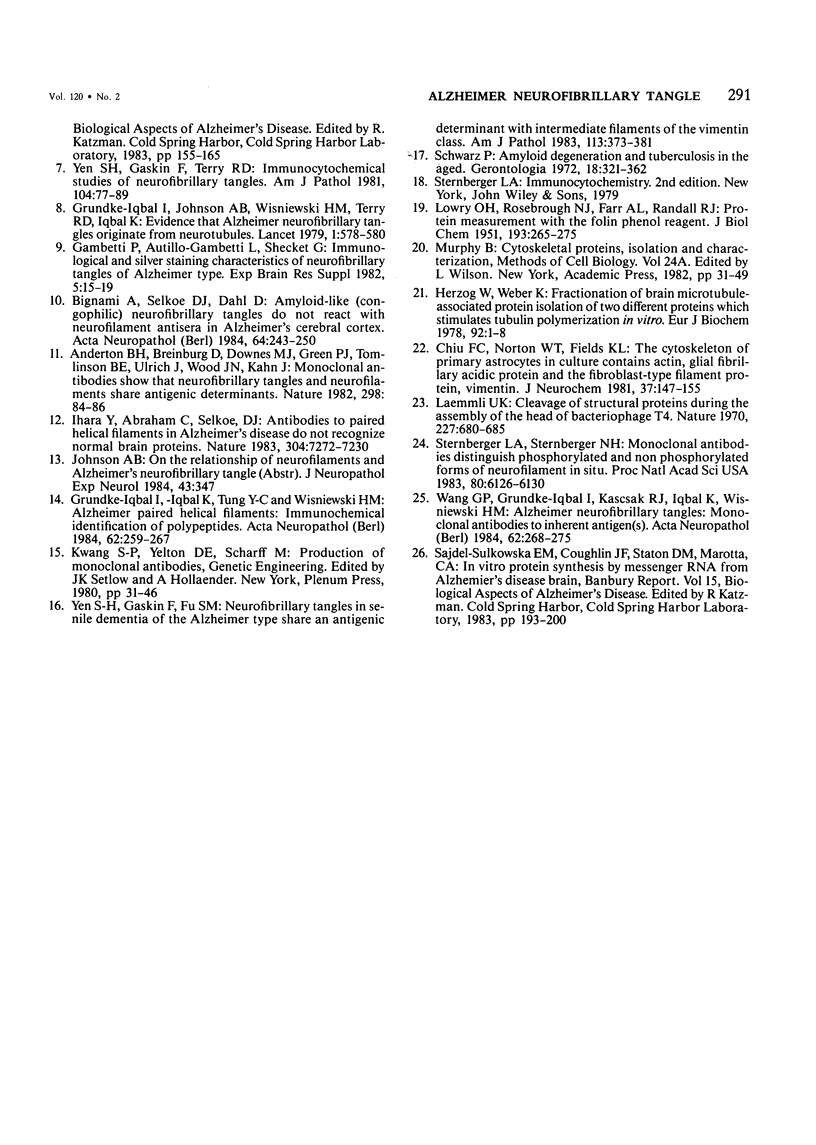Abstract
Ten monoclonal antibodies to Alzheimer neurofibrillary tangles (ANTs) were produced by immunizing mice with a brain homogenate from senile dementia of the Alzheimer type (SDAT). In methanol-fixed isolated neuronal perikarya, six of these antibodies reacted with nearly every ANT, three recognized 70-88% of ANTs, and one bound to less than 30% of ANT. In paraffin sections, three of the antibodies did not bind to tangles that had been fixed in formalin, three stained weekly, and four reacted with tangles in tissues that had been in formalin for more than a decade. Immunoblotting of brain homogenates showed that all but one antibody reacted with proteins from SDAT samples insoluble in SDS and too large to enter even the 3% polyacrylamide stacking gel. Polypeptides extractable by Tris buffer of molecular weight 58, 66, and 70 kd were detected in both normal and SDAT brains by two antibodies and only in SDAT brain by two other antibodies. One antibody did not show any reaction on the immunoblot. The results demonstrate that the epitopes recognized by these antibodies are not identical and that ANTs contain unique antigenic determinants as well as determinants in common with normal brain. Whether the unique determinants are acquired during tangle development or are essential in tangle formation remains to be investigated.
Full text
PDF









Images in this article
Selected References
These references are in PubMed. This may not be the complete list of references from this article.
- Anderton B. H., Breinburg D., Downes M. J., Green P. J., Tomlinson B. E., Ulrich J., Wood J. N., Kahn J. Monoclonal antibodies show that neurofibrillary tangles and neurofilaments share antigenic determinants. Nature. 1982 Jul 1;298(5869):84–86. doi: 10.1038/298084a0. [DOI] [PubMed] [Google Scholar]
- Bignami A., Selkoe D. J., Dahl D. Amyloid-like (Congophilic) neurofibrillary tangles do not react with neurofilament antisera in Alzheimer's cerebral cortex. Acta Neuropathol. 1984;64(3):243–250. doi: 10.1007/BF00688115. [DOI] [PubMed] [Google Scholar]
- Chiu F. C., Norton W. T., Fields K. L. The cytoskeleton of primary astrocytes in culture contains actin, glial fibrillary acidic protein, and the fibroblast-type filament protein, vimentin. J Neurochem. 1981 Jul;37(1):147–155. doi: 10.1111/j.1471-4159.1981.tb05302.x. [DOI] [PubMed] [Google Scholar]
- Gambetti P., Autilio-Gambetti L., Shecket G. Immunological and silver staining characteristics of neurofibrillary tangles of Alzheimer type. Exp Brain Res. 1982;Suppl 5:15–19. doi: 10.1007/978-3-642-68507-1_3. [DOI] [PubMed] [Google Scholar]
- Grundke-Iqbal I., Iqbal K., Tung Y. C., Wisniewski H. M. Alzheimer paired helical filaments: immunochemical identification of polypeptides. Acta Neuropathol. 1984;62(4):259–267. doi: 10.1007/BF00687607. [DOI] [PubMed] [Google Scholar]
- Grundke-Iqbal I., Johnson A. B., Wisniewski H. M., Terry R. D., Iqbal K. Evidence that Alzheimer neurofibrillary tangles originate from neurotubules. Lancet. 1979 Mar 17;1(8116):578–580. doi: 10.1016/s0140-6736(79)91006-7. [DOI] [PubMed] [Google Scholar]
- Herzog W., Weber K. Fractionation of brain microtubule-associated proteins. Isolation of two different proteins which stimulate tubulin polymerization in vitro. Eur J Biochem. 1978 Dec 1;92(1):1–8. doi: 10.1111/j.1432-1033.1978.tb12716.x. [DOI] [PubMed] [Google Scholar]
- LOWRY O. H., ROSEBROUGH N. J., FARR A. L., RANDALL R. J. Protein measurement with the Folin phenol reagent. J Biol Chem. 1951 Nov;193(1):265–275. [PubMed] [Google Scholar]
- Laemmli U. K. Cleavage of structural proteins during the assembly of the head of bacteriophage T4. Nature. 1970 Aug 15;227(5259):680–685. doi: 10.1038/227680a0. [DOI] [PubMed] [Google Scholar]
- Selkoe D. J., Ihara Y., Salazar F. J. Alzheimer's disease: insolubility of partially purified paired helical filaments in sodium dodecyl sulfate and urea. Science. 1982 Mar 5;215(4537):1243–1245. doi: 10.1126/science.6120571. [DOI] [PubMed] [Google Scholar]
- Shibayama H., Kitoh J. Electron microscopic structure of the Alzheimer's neurofibrillary changes in case of atypical senile dementia. Acta Neuropathol. 1978 Mar 15;41(3):229–234. doi: 10.1007/BF00690441. [DOI] [PubMed] [Google Scholar]
- Sternberger L. A., Sternberger N. H. Monoclonal antibodies distinguish phosphorylated and nonphosphorylated forms of neurofilaments in situ. Proc Natl Acad Sci U S A. 1983 Oct;80(19):6126–6130. doi: 10.1073/pnas.80.19.6126. [DOI] [PMC free article] [PubMed] [Google Scholar]
- Wang G. P., Grundke-Iqbal I., Kascsak R. J., Iqbal K., Wisniewski H. M. Alzheimer neurofibrillary tangles: monoclonal antibodies to inherent antigen(s). Acta Neuropathol. 1984;62(4):268–275. doi: 10.1007/BF00687608. [DOI] [PubMed] [Google Scholar]
- Yagishita S., Itoh Y., Amano N., Nakano T., Saitoh A. Ultrastructure of neurofibrillary tangles in progressive supranuclear palsy. Acta Neuropathol. 1979 Oct;48(1):27–30. doi: 10.1007/BF00691787. [DOI] [PubMed] [Google Scholar]
- Yen S. H., Gaskin F., Fu S. M. Neurofibrillary tangles in senile dementia of the Alzheimer type share an antigenic determinant with intermediate filaments of the vimentin class. Am J Pathol. 1983 Dec;113(3):373–381. [PMC free article] [PubMed] [Google Scholar]
- Yen S. H., Gaskin F., Terry R. D. Immunocytochemical studies of neurofibrillary tangles. Am J Pathol. 1981 Jul;104(1):77–89. [PMC free article] [PubMed] [Google Scholar]















